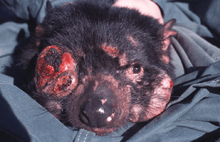Anne-Maree Pearse
Anne-Maree Pearse is an Australian cytogeneticist who is credited with the theory that some cancer cells can be transmissible between individuals. This is known as the Allograft Theory. Her work has focussed on devil facial tumour disease (DFTD), a contagious cancer that affects Tasmanian devils. For this she has won multiple awards, including the 2012 Prince Hitachi Prize for Comparative Oncology.
Anne-Maree Pearse | |
|---|---|
| Alma mater | University of Sydney University of Tasmania |
| Known for | Devil facial tumour disease |
| Awards | 2011 Australian Museum Eureka Prize 2012 Prince Hitachi Prize |
| Scientific career | |
| Fields | Cytogenetics |
Education
Pearse graduated from the University of Sydney in 1972 before starting an MSc at the University of Tasmania in 1976.[1] During her Masters she worked on the flea, Uropsylla tasmanica, which is a flea that infects quolls and Tasmanian devils.[1]
Career
Pearse worked in the Cytogenetics Laboratory at the Royal Hobart Hospital, Tasmania for seventeen years where she worked on human leukemia but also continued studying quolls.[1][2][3] During this period she published work on cancer in quolls.[4] She initially retired from scientific work, establishing a flower farm, before returning to science to work on DFTD.[5] She joined the Save the Tasmanian Devil program at the Department of Primary Industries, Parks, Water and Environment, Tasmanian Government, in 2004 after hearing about the disease on the radio.[1][3]

In 2006, Pearse and her colleague Swift published a paper on their findings on DFTD in Nature.[6] In their report they studied tumours from eleven Tasmanian devils. They observed that the tumours had major chromosomal abnormalities and these abnormalities were the same between individual animals. This led them to conclude that the tumour cells in different animals were of the same clonal origin. As a result, they proposed the hypothesis that "the disease is transmitted by allograft, whereby an infectious cell line is passed directly between the animals through bites they inflict on one another.".[6]
Since then, other scientists have added further evidence to the Allograft Theory of DFTD whilst Pearse has continued to uncover new information on the disease.[7] In particular, she has investigated how the disease mutates in Tasmanian Devil populations.[8] The conclusion of this research is "that DFTD should not be treated as a static entity, but rather as an evolving parasite with epigenetic plasticity".[9]
Awards and honours
- 2011 Australian Museum Sherman Eureka Prize for Environmental Research (shared)[10]
- 2012 Prince Hitachi Prize for Comparative Oncology[1][8]
References
- "The Awardee of the 2012 Prince Hitachi Prize for Comparative Oncology". jfcr.or.jp. Retrieved 2019-03-23.
- Melrose, W. D.; Pearse, A. M.; Bell, P. A.; Jupe, D. M.; Baikie, M. J.; Twin, J. E.; Bryant, S. L. (1990). "Haematology of the Australian eastern quoll, Dasyurus viverrinus--II. Red cell enzymes and metabolic intermediates". Comparative Biochemistry and Physiology. B, Comparative Biochemistry. 97 (1): 47–48. doi:10.1016/0305-0491(90)90175-S. ISSN 0305-0491. PMID 2147643.
- Julie Rehmeyer (March 31, 2014). "Fatal Cancer Threatens Tasmanian Devil Population". Discover Magazine. ISSN 0274-7529.
- Twin, J. E.; Pearse, A. M. (1986). "A malignant mixed salivary tumour and a mammary carcinoma in a young wild eastern spotted native cat Dasyurus viverrinus (Marsupialia)". Journal of Comparative Pathology. 96 (3): 301–306. doi:10.1016/0021-9975(86)90050-2. ISSN 0021-9975. PMID 3013953.
- Quammen, David (2008). "Contagious Cancer". Harper's Magazine. ISSN 0017-789X. Retrieved 2019-03-23.
- K. Swift; Pearse, A.-M. (2006-02-02). "Allograft theory: Transmission of devil facial-tumour disease". Nature. 439 (7076): 549. Bibcode:2006Natur.439..549P. doi:10.1038/439549a. ISSN 1476-4687. PMID 16452970.
- Pye, R. J.; Woods, G. M.; Kreiss, A. (2015-12-13). "Devil Facial Tumor Disease". Veterinary Pathology. 53 (4): 726–736. doi:10.1177/0300985815616444. ISSN 1544-2217. PMID 26657222.
- "Devil scientist wins Japanese prize". ABC News. 1 March 2011. Retrieved 24 June 2019.
- Ujvari, Beata; Pearse, Anne-Maree; Peck, Sarah; Harmsen, Collette; Taylor, Robyn; Pyecroft, Stephen; Madsen, Thomas; Papenfuss, Anthony T.; Belov, Katherine (7 January 2013). "Evolution of a contagious cancer: epigenetic variation in Devil Facial Tumour Disease". Proceedings of the Royal Society B: Biological Sciences. 280 (1750): 20121720. doi:10.1098/rspb.2012.1720. PMC 3574417. PMID 23135679.
- "The Australian Museum Eureka Prize Winners for 2011". theaustralian.com.au. 2011-09-06. Retrieved 2019-03-23.